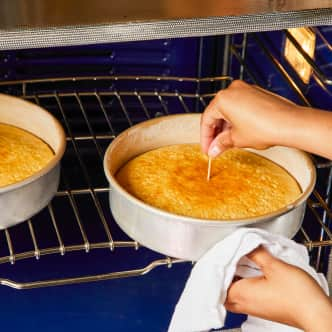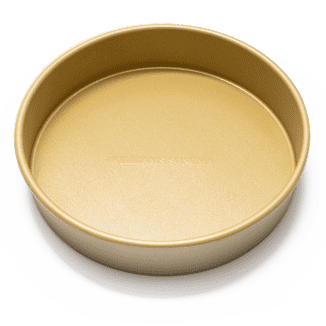Our favorite round cake pan, the light-colored Williams Sonoma Goldtouch Pro Nonstick Round Cake Pan, produced tall, evenly baked, golden-brown cake. It also turned out uniformly well-browned pizza. All food baked in it slid out easily, thanks to the pan’s nonstick coating. Our Best Buy is the Nordic Ware Naturals Nonstick 9" Round Cake Pan. It performed almost exactly as well as our favorite, and costs about half as much. We also tested and liked the 8-inch version of both of these pans, the Williams Sonoma Goldtouch Pro 8-Inch Nonstick Round Cake Pan and the Nordic Ware Naturals Nonstick 8" Round Layer Cake Pan.

Whether you’re baking layer cakes, upside-down fruit cakes, pan pizza, or cinnamon buns, a good cake pan is a baker’s best friend. After all your hard work of measuring, mixing, and baking, it’s disappointing and frustrating to pull your cake out of the oven and realize it’s unevenly baked or that it’s stuck to the pan. To produce tall layers and to accommodate voluminous fruit upside-down cakes, we like round cake pans that are at least 2 inches deep. We vetoed angled sides because straight sides make better layer cakes. To find out which cake pan is best, we purchased and tested a range of cake pans. We baked Fluffy Yellow Layer Cake and Pepperoni Pan Pizza in each, comparing the results.


We used the pans to make yellow cake and pepperoni pan pizza.
What Size Cake Pan Should I Get?
Cake pans are generally identified by their diameter. In our recipes, we most commonly use pans with a diameter of 9 inches, though we also call for pans with a diameter of 8 inches from time to time. However, you can use either 9- or 8-inch cake pans for almost any cake recipe; the same volume of batter will fill either two 9-inch pans or three 8-inch pans. There are a few points to keep in mind. If you're making three 8-inch layers instead of two 9-inch layers, be aware that the 8-inch layers will be thinner and bake more quickly than the 9-inch layers. Begin checking their doneness a few minutes earlier than the time called for in a recipe that uses only two 9-inch cake pans. Second, you will need about one more cup of frosting to fill and frost a three-layer cake compared to a two-layer cake, given the extra layer of frosting in the middle. Lastly, 9-inch rounds are thick enough to be split in half horizontally and thus can be made into a four-layer cake, while 8-inch rounds are generally too thin to do so.


What to Look For
- Light-Colored Pans: We slightly preferred light pans to dark ones. The two light-colored pans in our lineup produced golden brown and evenly baked cake. The cake was tall and airy with a flat, even top. Baking in a light colored pan reduces the chance that you will over-bake your cakes because the browning happens more slowly than in a dark pan. We’re happy to note the pan’s light color didn’t prevent it from developing deep browning when we made pizza in it.

- Slick Nonstick Surface: Pans in our lineup with a good nonstick coating released all food with ease, leaving nothing behind. Delicate cake and sticky pizza slid out of these pans completely intact, looking beautiful. Nonstick coatings also make for a quick cleanup.

Nice to Have
- Handles: Two of the pans in our lineup had distinct wide handles, which made it easier to rotate them in the oven as well as move them from the oven to the cooling rack. We loved how secure our grip felt, even with bulky oven mitts on.
What to Avoid
- Uncoated Pans: Pans without nonstick coatings make it very challenging to remove food without damaging it. Despite thorough greasing, pizza fused to the pans without nonstick coating. They are also harder to clean than pans with nonstick coating.

Other Considerations
- Dark Pans: The darker the pan, the darker the cake. A dark-colored pan absorbs heat more efficiently than a light-colored pan. While browning does improve flavor, darker pans sometimes also produced cakes that were distinctly or slightly domed, which can make stacking, icing, and decorating them more difficult. Although a dark interior is not a deal breaker, it’s important to note, especially when baking something light and delicate like a yellow cake layer–you’ll want to start checking its doneness a minute or two sooner than when you bake cakes in a light pan.


 Buy at Williams Sonoma
Buy at Williams Sonoma


















